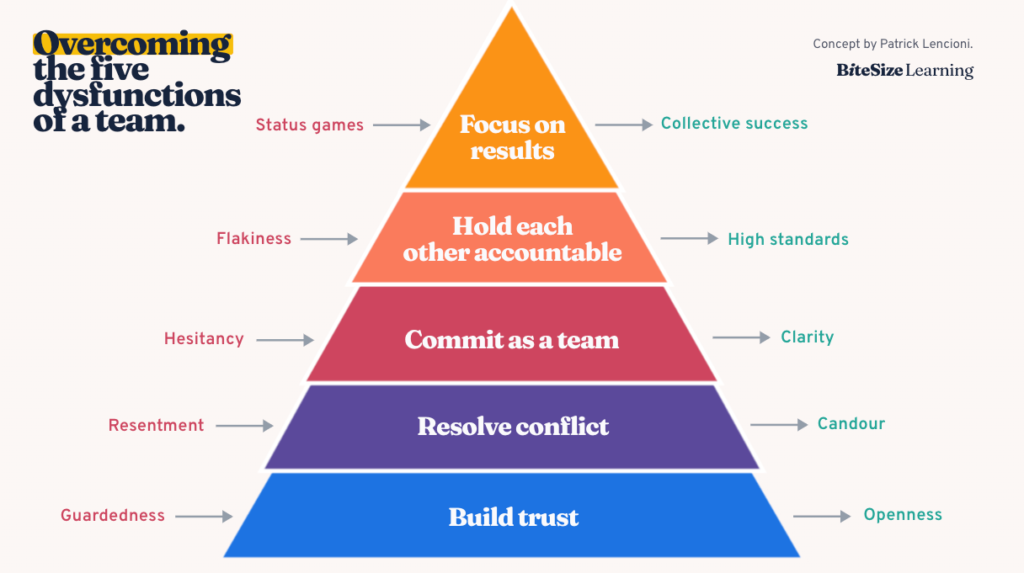How to Fix a Dysfunctional Team: Lessons from The Five Dysfunctions of a Team
Is your team struggling to achieve its goals? Do you sense underlying tension, unresolved conflicts, or a general lack of trust? You might be experiencing the “five dysfunctions of a team,” a concept popularized by Patrick Lencioni in his bestselling book, The Five Dysfunctions of a Team: A Leadership Fable. This post dives deep into these dysfunctions and provides actionable strategies to build a high-performing, cohesive team.
Understanding the Five Dysfunctions of a Team
Lencioni presents a pyramid model, where each dysfunction builds upon the previous one. Addressing the foundation is crucial for overcoming the higher-level challenges.
1. Absence of Trust
Description: This is the foundation of the pyramid. Without trust, team members are hesitant to be vulnerable and honest with each other. They fear judgment, punishment, or exposure of their weaknesses.
Symptoms:
- Hiding mistakes and weaknesses
- Reluctance to ask for help
- Holding back ideas and opinions
- Avoidance of conflict
Solutions:
- Personal Histories Exercise: Team members share their backgrounds, including successes and failures, to foster empathy and understanding.
- Team Effectiveness Exercise: Each member identifies the single most important contribution that each of their peers makes to the team, as well as one area that they could improve upon, and discuss the feedback with the other members.
- 360-Degree Feedback: Provide anonymous feedback to team members to surface blind spots and areas for improvement. See research on the effectiveness of 360-degree feedback (Harvard Business Review – Why 360 Reviews Can Fail) for best practices.
- Vulnerability-Based Trust Building: Leaders must model vulnerability by sharing their own mistakes and weaknesses.
2. Fear of Conflict
Description: When trust is absent, teams avoid conflict, mistaking it for unnecessary drama. However, productive conflict is essential for exploring different perspectives and arriving at the best solutions.
Symptoms:
- Artificial harmony
- Gossip and backstabbing
- Avoidance of difficult conversations
- Stifled innovation
Solutions:
- Mining for Conflict: Leaders should actively encourage debate and dissent, even playing “devil’s advocate” to challenge assumptions.
- Real-Time Permission: Remind team members that conflict is healthy and necessary. Explicitly give permission to disagree.
- Thomas-Kilmann Conflict Mode Instrument (TKI): Understand individual conflict styles and how they impact team dynamics. (CPP – Thomas-Kilmann Conflict Mode Instrument Sample Report)
- Establish Norms for Conflict: Agree on ground rules for how conflict will be handled (e.g., focusing on issues, not personalities).
3. Lack of Commitment
Description: Without productive conflict, team members may feign agreement but harbor doubts and reservations. This leads to a lack of commitment to decisions and goals.
Symptoms:
- Ambiguity and uncertainty
- Missed deadlines
- Second-guessing decisions
- Lack of buy-in
Solutions:
- Cascading Messaging: Ensure decisions are clearly communicated and reinforced throughout the organization.
- Deadlines: Set clear deadlines for decisions and actions.
- Contingency Planning: Identify potential obstacles and develop plans to address them. Helps build confidence and reduces ambiguity.
- Worst-Case Scenario Analysis: Explore the potential negative consequences of a decision to alleviate fears and build commitment.
4. Avoidance of Accountability
Description: When team members aren’t committed to decisions, they’re less likely to hold each other accountable for results. This can lead to poor performance and resentment.
Symptoms:
- Low standards
- Missed deadlines
- Blaming others
- Resentment
Solutions:
- Publication of Goals and Standards: Make goals and standards public and transparent.
- Regular Progress Reviews: Hold regular meetings to track progress and address any issues.
- Team Rewards: Reward team performance, not just individual contributions.
- Direct Feedback: Encourage team members to provide direct, constructive feedback to each other.
5. Inattention to Results
Description: The ultimate dysfunction occurs when team members prioritize individual goals or status over collective results. This undermines the entire purpose of the team.
Symptoms:
- Stagnant performance
- Loss of competitive advantage
- Disengaged employees
- Focus on individual career goals
Solutions:
- Public Declaration of Results: Clearly define and communicate team goals and objectives.
- Results-Based Rewards: Tie rewards and recognition to team performance.
- Regular Performance Reviews: Track progress against goals and address any shortfalls.
- Leadership Modeling: Leaders must consistently prioritize team results over individual achievements.
Overcoming Team Challenges: Leadership is Key
Addressing these dysfunctions requires strong leadership. Leaders must be willing to:
- Model vulnerability and trust
- Facilitate productive conflict
- Encourage commitment
- Hold team members accountable
- Focus on results
Building a high-performing team is an ongoing process. It requires consistent effort, open communication, and a willingness to address difficult issues head-on. By understanding and addressing the five dysfunctions, you can create a team that is more cohesive, productive, and successful.
Actionable Strategies in Journey App
The Five Dysfunctions of a Team offers powerful concepts, but applying them consistently in real-world scenarios can be challenging. That’s where Journey App can help. Journey App uses AI to personalize these leadership strategies and integrate them into your daily workflow. Track team dynamics, prompt vulnerability-based discussions, encourage healthy conflict resolution, and ensure accountability through personalized action plans – all tailored to your team’s unique challenges. Start building a stronger, more cohesive team today!


